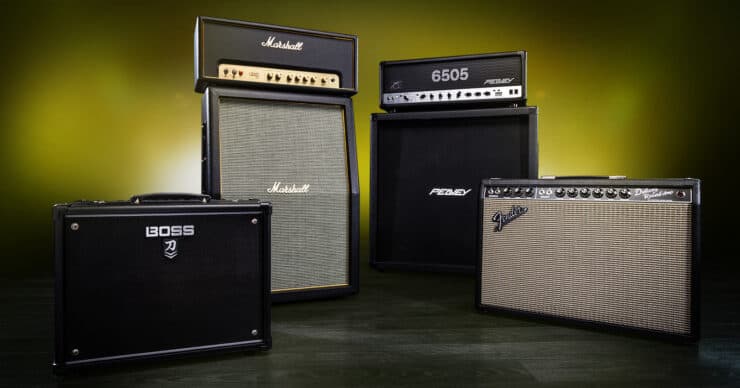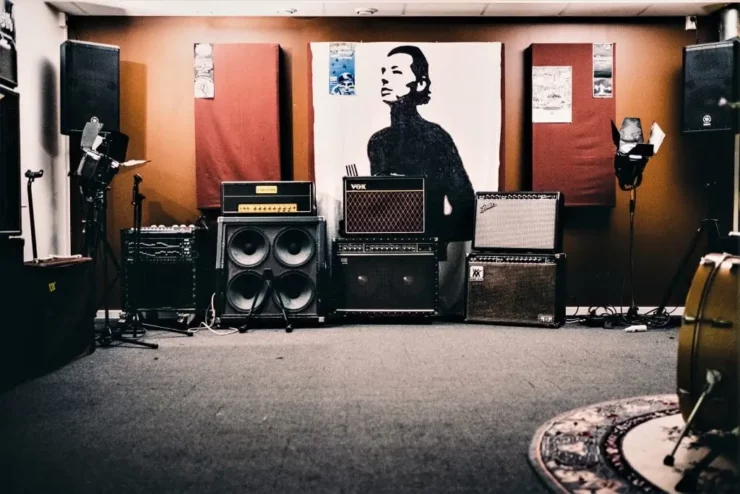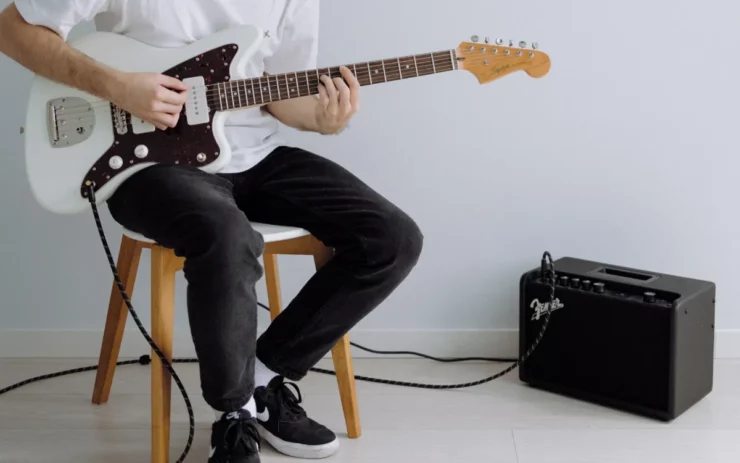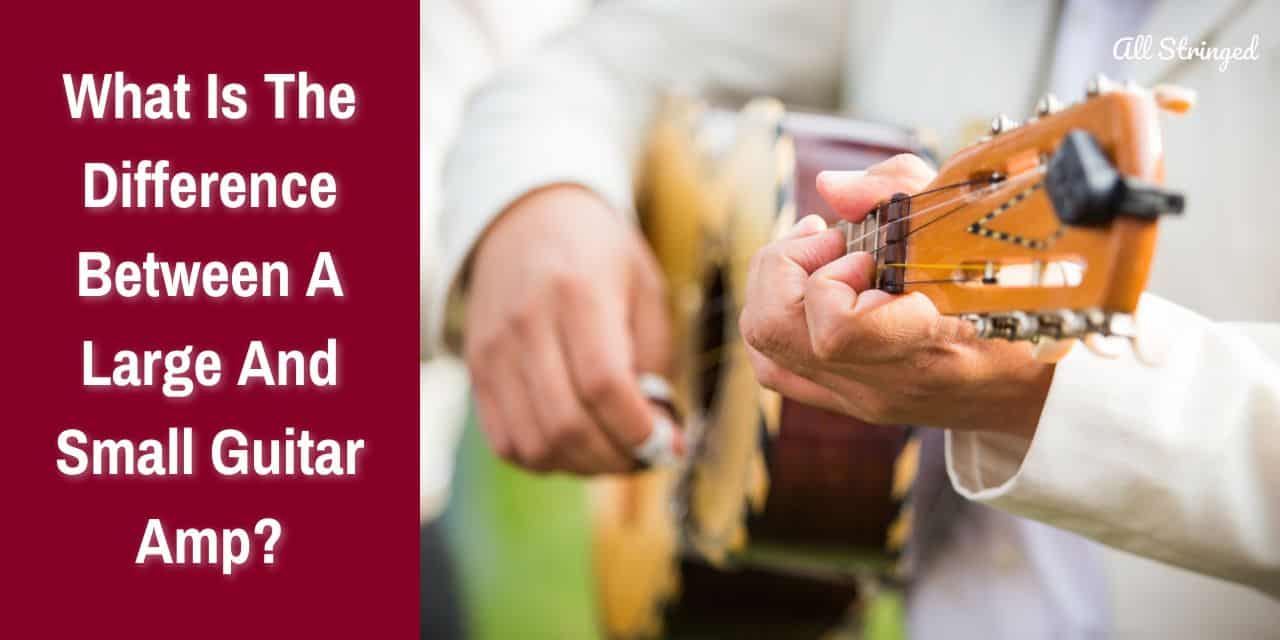Are you a guitarist struggling to decide between a large and small amp? Are you unsure of the difference between the two, and what each provides? Look no further! In this article, we will explore the key differences between large and small guitar amps, and how to choose the right amplifier for your musical needs. Whether you are a beginner or a seasoned professional, this article will provide you with the information you need to make an informed decision and get the best sound out of your guitar! So keep reading to learn more about large and small guitar amps, and which one is right for you.
What is the difference between a large and small guitar amp?
Choosing the right guitar amp is an important decision for guitarists as it will greatly influence the tone and overall playing experience. When you’re considering a guitar amp, one of the considerations you need to make is whether you should go for a large or small guitar amp. Here, you will find out some of the major differences between a large and small guitar amp. These differences will help you make well-informed decisions that suit your playing styles and needs.
#1. Power rating
Large guitar amps typically come with higher power ratings typically ranging from 30W to several hundred watts. Higher wattage will allow for more headroom, cleaner tones, and the ability to play at louder volumes without distortion. In fact, you will be able to achieve louder tones and maintain cleaner tones even when you are playing at higher levels. Large guitar amps are perfect for live performances, band rehearsals, and gigs that demand substantial output.
>>> Click here to read our review about the Top 15 Best Small Guitar Amps <<<
Meanwhile, small guitar amps typically come with lower power ratings and they range between 1W and 20W. While they might not offer as much volume or headroom as larger amps, they excel in delivering desirable tube saturation and natural overdrive at lower volume levels. Small guitar amps are perfect for home practice, studio recording, and intimate performances.

#2. Speaker size
Large guitar amps often feature large speakers, such as 12-inch or 15-inch speakers. These larger amps produce a fuller, deeper, and more resonant sound, delivering greater low-end response and overall presence. They give an enhanced low-end response, increased projection, and improved overall presence, which makes them suitable for genres that need robust and impactful sound.
Small amps typically come with smaller speakers, such as 8-inch or 10-inch speakers. Despite having a small size, these speakers can still offer excellent tone and clarity. Such amps are well-suited for practice sessions, home recordings, and situations where portability is important.
#3. Tone controls
Large guitar amps generally feature more extensive tone control options, including separate controls for bass, treble, and midrange frequencies. These controls will allow for precise shaping of the sound, offering greater versatility in dialing in desired tones. With a level of versatility and adaptability, these amps are ideal for various musical genres and playing styles.
Small guitar amps, on the other hand, feature simplified tone control sections, with fewer knobs or controls. While they might not offer quite as much tonal flexibility, they still have intuitive and straightforward controls, making it easier to achieve great tones quickly. This simplicity can be beneficial for beginners or guitarists who are looking for a straightforward approach to tone shaping.
#4. Effects
Large guitar amps come equipped with built-in effects, such as delay, reverb, modulation, and built-in multi-effects processors. These amps offer an impressive range of effects options, allowing musicians and guitarists to experiment with various sounds without requiring external pedals. This convenience makes large guitar amps ideal for musicians looking for versatility and convenience.
Small guitar amps typically come with fewer built-in effects, focusing more on delivering a clean and natural tone. However, they often come with an effects loop that allows you to connect external effects pedals for more customization. This feature ensures that small amps are able to accommodate guitarists who prefer specific effects pedals.
#5. Connectivity
Large guitar amps typically offer a wider range of connectivity options. They often come with multiple inputs and outputs, including auxiliary inputs for connecting external devices like phones or MP3 players, line outputs for recording or connecting to a PA system, and footswitch jacks for controlling various amp functions. These extensive connectivity options make large guitar amps highly versatile and adaptable to various performance scenarios.
Small guitar amps typically offer all the basic connectivity options, such as an input for your guitar and, in some cases, a headphone output for silent practice. While they might not have as many auxiliary connections or outputs as larger guitar amps, they still offer the essential connectivity required for most practice and recording situations.
Pros of large guitar amps
When it comes to guitar amps, bigger doesn’t necessarily mean. However, there are definitely numerous undeniable advantages to using large guitar amps. Whether you are a professional musician performing on big stages or just a tone enthusiast looking for unparalleled sonic possibilities, large guitar amps have a lot to offer. Here, you will get to know about the pros of large guitar amps, highlighting their power, versatility, stage presence, and more.

#1. Amplified power
One of the most significant advantages of large guitar amps is their amplified power. These amps typically come with higher wattage ratings, which allow for ample headroom and cleaner tones even at higher volumes. Having increased power output will ensure that your guitar is able to cut through the mix, making large amps perfect for live performances, band rehearsals, and gigs in large venues.
#2. Extended frequency response
Large guitar amps tend to feature large speakers, such as 12-inch or 15-inch models. These larger speakers will provide a more extended frequency response, resulting in a fuller and more resonant sound. These amps also excel in delivering the rich low-end response, allowing for thunderous bass notes and punchy rhythm guitar tones. The extended frequency response of larger amps will add depth and presence to your overall sound.
#3. Versatile tone controls
Large guitar amps will typically offer comprehensive tone control sections. With separate controls for bass, treble, and midrange frequencies, these amps will provide greater flexibility in shaping your desired tone. The additional control options will allow you to fine-tune your sound, accommodating various musical genres and playing styles. Whether you prefer deep and heavy tones or crisp and articulate sounds, large amps will offer the versatility to dial in your desired tonal characteristics.
#4. Built-in effects and signal processing
Many large guitar amps come equipped with built-in effects and signal processing capabilities. These amps often feature a wide range of effects, such as delay, reverb, modulation, and even multi-effects processors. The inclusion of built-in effects will eliminate the need for external pedals, simplifying your setup and offering a wide range of sonic possibilities at your fingertips. This convenience is especially advantageous for musicians who perform regularly and need quick access to different effects.
#5. Connectivity and stage presence
Large guitar amps typically come with a broader range of connectivity options, accommodating diverse performance scenarios. They often come with multiple inputs and outputs, auxiliary inputs for connecting external devices like smartphones or MP3 players, line inputs for recording or connecting to PA systems, and footswitch jacks for controlling different amp functions. These extensive connectivity options will enhance your ability to integrate with other gear and provide seamless integration with the stage and studio setups.
Further, large guitar amps also come with a commanding stage presence. Their large size and visual impact will enhance the overall aesthetics of your performance, making a statement and capturing the attention of the audience. The physical presence of a large amp adds to the immersive live music experience and contributes to the overall stage atmosphere.
Cons of large guitar amps
While large guitar amps do offer a lot of benefits in terms of power, versatility, connectivity, and more, it is essential that you consider the potential drawbacks that come with their size and features. These amps are not perfect as there are certain sections that these amps lack in. Here, you will get to know some of the cons of large guitar amps and have a balanced perspective to help you make a smarter decision when selecting the right guitar amp for your needs.
#1. Size and portability
One of the most evident drawbacks of large guitar amps is their massive size and weight. These guitar amps are typically bulkier and heavier, which makes them less portable in comparison to their smaller counterparts. Transporting large guitar amps to gigs, rehearsals, or practice sessions can be cumbersome, especially if you have limited space or have to navigate stairs and tight corners. The weight and size of large guitar amps can pose challenges for musicians who need mobility or regularly travel with their gear.
#2. Volume management
While the amplified power of large guitar amps is often seen as a major advantage, it can also become a drawback in certain situations. Larger guitar amps tend to have higher wattage, which results in louder volume capabilities. This can be a problematic issue if you have to frequently play in small venues or practice spaces where lower volumes are needed. Managing the volume of a large guitar amp might necessitate attenuators or soundproofing solutions, which can add complexity and cost to your setup.

#3. Limited applications
Large guitar amps are designed with a particular focus on power and stage performance. This might limit their suitability for certain contexts. If you typically play at home, in a bedroom, or in a small studio setting, the high wattage and volume capabilities of large amps might be excessive. Using a large guitar amp at lower volumes might not allow you to fully unleash its potential. It can typically limit the tonal characteristics and dynamics that these guitar amps are known for.
#4. Complexity and learning curve
Large guitar amps often come equipped with extensive tone control options, built-in effects, and advanced signal processing capabilities. While these features offer high versatility and creativity, they can even introduce complexity, especially for beginner musicians or guitarists who prefer a simpler setup. Navigating a large guitar amp’s control panel and understanding various settings and functions might require a steeper learning curve, potentially adding time and effort to your playing and setup routine.
#5. Cost
Another important consideration when opting for a large guitar amp will be the cost. Larger guitar amps come with higher power ratings, advanced features, and premium components that tend to be more expensive than smaller, simpler models. Investing in a large guitar amp can be a significant financial commitment, especially for musicians on a limited budget. It is important to weigh the cost against your playing needs and goals to ensure that the investment aligns with your priorities.
Pros of small guitar amps
When you are in the market for a guitar amp, small does not mean that the amp packs in quality or capability. Small guitar amps have their own set of advantages that make them highly appealing to musicians. Here, you will get to know the pros of small guitar amps, highlighting the different benefits you will enjoy when you go for a small guitar amp.
#1. Portability and convenience
One of the most significant advantages of small guitar amps is their portability. These guitar amps are extremely compact, lightweight, and easy to carry, which makes them perfect for musicians on the go. Whether you are heading out for band practice, a jam session, or a gig at a smaller venue, a small amp can be easily transported without much hassle. Moreover, their smaller size will allow for more straightforward storage and setup, saving you space in your practice area or studio.
#2. Practice-friendly volume levels
Small guitar amps typically come with lower wattage ratings, which means that they excel at delivering excellent tone and dynamics at lower volume levels. This makes them well-suited for practice sessions, home playing, and situations where you have to maintain a controlled volume. You’ll be able to enjoy the rich overdrive and tone characteristics of a small guitar amp without disturbing neighbors or household members. The ability to achieve desirable tones at lower volumes will be especially advantageous for late-night or apartment playing.
#3. Versatility and tone options
Although small guitar amps might not have as many built-in effects or intricate tone control options as their larger counterparts, they still offer a surprising level of versatility. Many small guitar amps include basic EQ controls for adjusting bass, treble, and midrange frequencies, allowing you to easily share your desired tone to a certain extent. Moreover, small guitar amps often have a distinct character and warmth, especially in the realm of tube amps, providing a unique sonic flavor that can enhance your playing.
#4. Recording and studio applications
Small guitar amps are exceptional tools for recording and studio work. Their lower wattage generally translates to easier mic placement and more manageable sound isolation. Due to the smaller size, they can be positioned in close proximity to mics, allowing you to capture the nuances of your playing with precision. Small guitar amps are also popular among home studio enthusiasts who want to achieve professional-quality guitar tones without the need for extensive isolation booths or high-volume levels.
#5. Cost-effectiveness
Another major advantage of small guitar amps is their affordability. In general, small guitar amps by the big-name amp brands like Blackstar, Boss, and more tend to be more budget-friendly in comparison to larger amps. If you are a beginner or have a limited budget, a small guitar amp will offer a cost-effective option to start honing your skills and exploring different tones. Despite their lower price points, many small guitar amps deliver impressive sound quality and performance, making them a great investment for players at any level.
Cons of small guitar amps
While small guitar amps do offer benefits in terms of portability and convenience, it is important that you consider their limitations and potential drawbacks. Here are some of the major cons of small guitar amps to give you a balanced view of whether or not a small guitar amp is ideal for you.
#1. Volume limitations
One of the most apparent drawbacks of small guitar amps is their limitations in terms of volume capabilities. Due to their lower wattage ratings and smaller speaker sizes, small guitar amps might struggle to project sound with the same power and projection as larger amps. This can be problematic when playing in larger venues or with a band where you need to cut through the mix. It is worth noting that while small guitar amps can provide excellent tone at lower volumes, pushing them to their maximum volume might result in distortion and compromised sound quality.
#2. Reduced tonal versatility
Small guitar amps come with fewer tone-shaping options in comparison to their larger counterparts. While some small amps come with basic EQ controls, they might lack the extensive tone control options, built-in effects, and signal process capabilities found in larger amps. This limited flexibility could make it challenging to achieve a wide range of tones and might require additional external pedals or processors to expand the sonic possibilities. Consequently, small guitar amps might be better suited for specific musical genres or playing styles, potentially limiting their versatilities for musicians who need a broader tonal palette.
#3. Lack of stage presence
Small guitar amps, by nature, have a more compact and subtle physical presence. This can result in reduced stage presence, especially in larger performance settings. While this might not be an issue for intimate performances or studio recordings, it can be a disadvantage if you are looking for a visually striking setup or want to make a visual impact on stage. The size and visual appeal of a guitar amp can contribute to the overall stage aesthetic and enhance the experience for both performers and the audience.
#4. Limited headroom
Small guitar amps can suffer from limited headroom, which refers to the ability to handle higher input levels without distortion. As you increase the volume on a small amp, you might encounter early onset of clipping or distortion, especially with tube amps. This can be quite problematic if you need lean and pristine tones at higher volume levels. It is important that you assess your playing style and performance needs for determining if a small guitar amp can adequately accommodate your desired sound without compromising clarity and dynamic range.
#5. Speaker size limitations
Small guitar amps typically come with smaller speaker sizes such as 8 inches or 10 inches, which can greatly impact their overall sound reproduction. Smaller speakers might have limitations in reproducing low frequencies and might lack the depth and presence of larger speakers. This can affect the overall tonal balance and might require additional adjustments or external solutions to compensate for any perceived deficiencies.
FAQs
What is the main difference between a large and small guitar amp?
The main difference between a large and small guitar amp is size and power. Large amps are usually more powerful and louder than smaller amps, so they are typically used for larger venues and live performances. Smaller amps are more portable and typically have lower wattage and smaller speaker size, making them ideal for practice or small venues.
What are the benefits of using a large guitar amp?
Large guitar amps are typically more powerful, allowing them to provide more volume and projection for large venues and live performances. They also typically have more advanced features and controls, allowing for greater tonal flexibility.
What are the benefits of using a small guitar amp?
Small guitar amps are typically more affordable, portable, and easier to use. They also typically have lower wattage and smaller speaker size, making them ideal for practice and small venues. Small amps are also great for recording and can provide a more controlled sound than larger amps.



